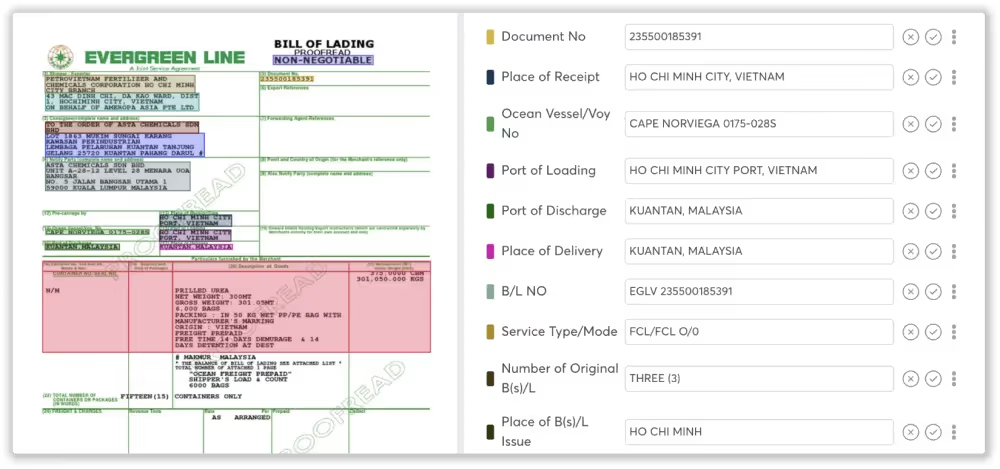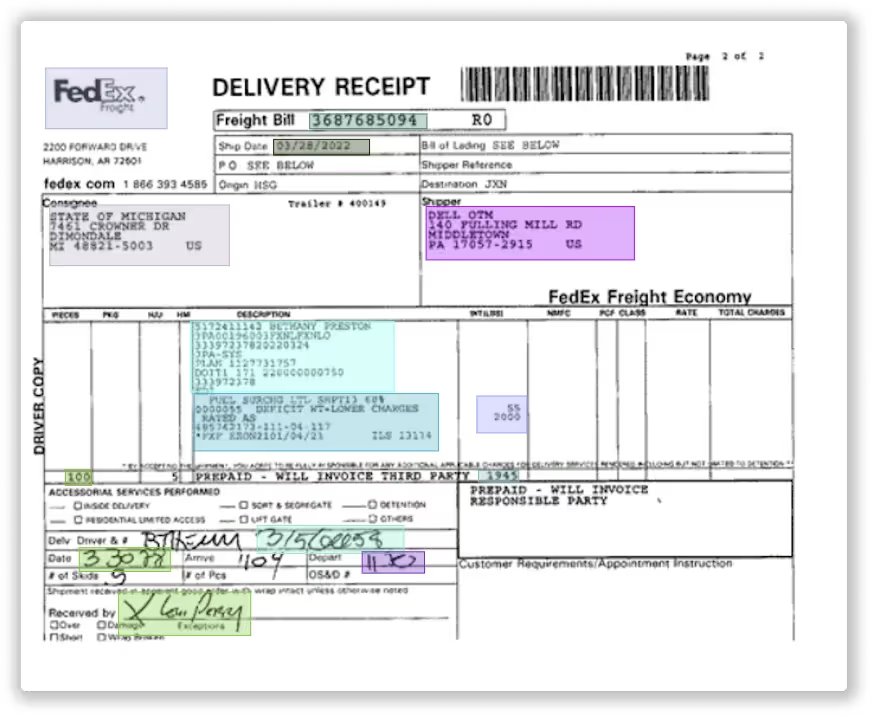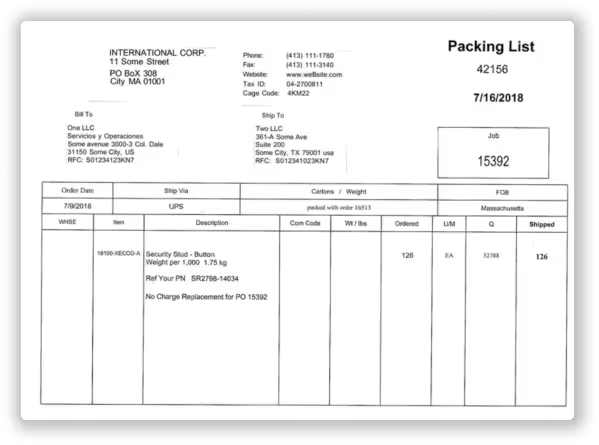

Logistics is one of the world’s largest industries, encompassing numerous sectors including road, rail, air, maritime transport, warehousing, and storage. While the word “logistics” itself dates back to the nineteenth century, emerging from “Logistique”— the supply of weaponry to soldiers, it now denotes the vast enterprise of planning, implementation, and control of the transport of goods through B2B, B2C and C2C supply chain networks. According to the IMARC Group, the global logistics market is expected to reach US$ 6.55 Trillion by 2027.
The transportation and logistics industry runs on enormous amounts of data generated by various activities such as rate management, customs declarations, invoicing, shipping, client management, vendor management, routing, and transport management. Logistics very much runs on “big data,” which is scattered across documents including commercial invoices, airway bills, letters of instructions, customs forms, proforma invoices, and many other structured, semi-structured, and unstructured document types. Logistics companies commonly process and store data in ledgers, files, folders, and databases that may contain physical papers, emails, texts, spreadsheets, word documents, PDFs, and/or scanned images.
The logistics industry is heavily dependent on blue collar workers for managing its vast stores of unstructured data. Unfortunately, manual data management is time-consuming and error-prone. Research suggests that humans have an error rate of 18-40% for simple spreadsheet data entry. These errors ultimately cost businesses time and money. The 1-10-100 data entry rule states that it costs:
Intelligent Document Processing (IDP) is a valuable tool in the logistics sector, offering a convenient, accurate, and rapid route to logical and semantic analysis of documents. IDP is well suited for extracting useful information from varied documents associated with the transfer of products from source to destination. Modern IDP solutions can accurately extract and process data such as names, dates, addresses, and amounts from structured, semi-structured and unstructured documents.
AI-powered IDP solutions minimize human involvement in document processing, only leveraging input from people to resolve edge cases and ensure quality. Human workers train AI models that learn continuously, improving accuracy and automation rates over time. This process allows AI projects to maintain or exceed user defined thresholds for quality, cost, and speed. IDP nearly eliminates endless, repetitive data extraction and entry tasks that humans are poorly suited for to begin with.
The shipping of a product from the vendor to a client through a carrier involves a document called the bill of lading, or BoL. A bill of lading is a legally binding document that provides the shipper and the carrier with all the necessary details to process a shipment. It is a written record of the items being shipped, their source, and their target destination. It also serves as a receipt once a shipment has been delivered.

The BoL is particularly important in the context of export because it contains vital information such as the safety and legality of the product being shipped, as well as the legitimacy of the provider, shipper, and consignee. It also contains information about freight charges and customs fees payable at freight/port authorities. Most importantly, it establishes ownership of the shipped product throughout as it makes its way to the final destination.
Commodity traders, food producers, shippers, and logistics providers process hundreds or thousands of bill of lading documents each day. While each carrier has its own BoL document format, almost all BoLs contain the following information:
Manual extraction and management of BoL data may be manageable for small carriers that deal with fewer suppliers and purchasers, but as a carrier expands its portfolio, some kind of automated data management system becomes essential to keep up.
Surveys show that in 2020 alone, 20 billion parcels were shipped in the United States. Each shipment creates a paper trail of documents, among which the proof of delivery is one of the most critical. It not only confirms the receipt of the product by the client, thereby adding to the credibility of the supplier, but is also directly connected to revenue generation. Proof of delivery slips help providers assess delays and plan future deliveries schedules with greater efficiencies. Invoices cannot be raised without proofs of delivery.

Most proof of delivery documents are printed on paper and require a signature from the recipient. More recently, proof of delivery documents moving into the digital domain. This makes sense, as paper is an inefficient medium for any kind of official communication because it can be easily lost or damaged, which leads to delays in invoicing. This may also enable fraud, with unscrupulous actors claiming non-receipt of a shipment that was delivered, leading to multiple deliveries, or unnecessary credit to customers and loss to suppliers.
With digital delivery slips, the customer is often required to sign using a digital pen or their finger on a handheld device, which is then stored in a database. In addition to the signature, proof of delivery also includes the names and addresses of supplier and recipient, and a description of the goods being delivered. All this information must be transferred into the overarching logistics data repository, which involves significant manual labour. Whether logistics documents come in digital or paper formats, errors can still occur if human workers are tasked with manual data entry at some point in the workflow.
The automation of the proof of delivery starts with the automatically capturing document data in a machine readable format. Intelligent Document Processing (IDP) solutions help overcome the time delays and cost penalties associated with manual or legacy OCR-based data extraction systems.
IDP of proof of delivery documents usually provide the following features:
Shipping of products from the source to the destination often involves intermediary players such as freight forwarders. Freight forwarding includes a variety of activities such as transportation and warehousing, packaging and documentation, insurance, and value-added services and act as a vital link in the supply chain. Freight forwarders are the point of contact between the source and destination. The global freight forwarding market size has been forecast to grow to $220.34 billion in 2026.

Among the plethora of documents that the freight forwarder deals with, the freight invoice or the freight bill is perhaps the most important in that it not only serves as a registry of the details of the shipment including source, recipient and product, but also includes the payment details. It is created by the freight forwarder and signed by the shipper and the carrier. Freight invoices are used by the accounting team as a base for billing the shipper or the receiver, depending on the contract terms.
The management of freight invoice is tedious because often a single shipment can have multiple invoices to be sent to various participants of the supply chain, all of which must be recorded in the larger repository. The sheer volume of data in these invoices can make freight invoice management prone to errors and delays. The automation of freight invoices can ease much of the management process and prevent costly errors.
IDP solutions can capture relevant data from a variety of formats of invoices. Such solutions can "learn" to recognize important data from new invoice types, which ensures that high levels of accuracy and fidelity are maintained.
Shipping labels are ID tags for shipped packages and are affixed to the package as it moves from source to destination. The formats of shipping labels differ depending upon the supplier or the freight forwarder but must contain vital information such as name and address of the recipient, name and address of the supplier/freight t forwarder, contact phone numbers, an indication of the item, its number and/or weight, shipping class etc. inside the package. These days, shipping labels also contain barcodes and electronic tracking numbers.
The extraction of data from shipping labels is important for all the links of the supply chain. The supplier or the freight provider usually prints the label, most likely from an existing database of customer information and may not need to extract data again from the label, except for quality control purposes. The other interim and final recipients need to scan the shipping labels and extract all the pertinent information to be stored in a repository so that the package can be tracked easily by all the members of the chain. The recipient is usually provided with an electronics tag for tracking the product through its passage from the source to the destination, and for this, the location of the package must be updated at every stage. This in turn means that all intermediate stops must extract the data from the packing labels to update its current status and location.

As mentioned earlier, shipping labels may be of many formats. The source and destination addresses may be at different locations on the package. The barcode may encode different types of data and may be placed anywhere in the package, and so on. In addition, since the package has to move across geographic distances, the label can become dirty, torn, or soiled over the passage.
Legacy OCR systems are less than useless in such situations because (a) the package is too large to be put under a scanner in which these OCR systems work, and (b) even zonal OCRs can be stumped at the varied locations of various information on the label. The human intelligence and eye can be error prone, especially with increase in volume of packages to be delivered (see earlier statistics on 20 billion parcels/year in the US).
IDPs are the only solutions for this, and can efficiently extract various fields and categorize them accurately for both data storage and data analysis and processing. The AI and ML engines in IDCs use statistical methods, neural networks, decision trees, and rule learning techniques for data understanding, rather than simple identification. For example, Computer-vision-based document layout tools present in many IDCs can differentiate between relevant and irrelevant fields and recognize the content irrespective of their position on the label . Named Entry Recognition (NEM) algorithms are trained to pick out specific types of information, such as reference numbers, names, addresses, cost, etc., and transfer them to the next job in the work process with high accuracy and efficiency. Thus, IDPs enable straight-through processing than field-level recognition because location coordinates are not necessary.
Insurance is a data-rich industry hinges on considerable amount of big data analytics. Given the many types of products being shipped across land, sea and air, there are also many kinds of insurance policies catering to the logistics sector. Some of the common insurance types used in the logistics industry are cargo insurance, freight forwarder liability insurance, marine services liability, hull and machinery, protection and indemnity, energy logistics, dangerous goods and fuel logistics insurance, commercial vehicle insurance, general liability, and so on.

The logistics insurance sector deals with large amounts of paperwork. There are auto accident claims, annuity account forms, disability forms, beneficiary forms, and more. Regardless of the insurance type, there are forms to fill and process. Various insurance parameters such as premiums, risk selection, underwriting, etc. run on large swaths of information that is present in both structured and unstructured documents.
Insurance processing requires correlation of data from multiple sources, which is a cumbersome process because it involves extracting, processing and analyzing data from disparate documents. There is need for human-like cognition to sort through all the details in different documents. With the advent of AI tools that come close to human-like cognition (even sentience some may say), there is now a vast scope for their use in the insurance sector. Many insurance companies are already looking to fully automate their operations; 46% of insurance claims activities are expected to be automated in the US by 2030, and much of this automation will be AI powered and will include an IDP component.
A customs declaration form provides details of goods that are being imported or exported. It consists of information such as country of origin, description of goods, cost, insurance and freight (CIF) details, customs classification number, duties, etc. Manual processing of customs declaration forms requires data from various documents such as invoices, waybills, certificates of origin, packing lists, etc. As with the earlier cases, such manual activities can be tedious and time consuming. IDP solutions can automate the processing of customs declaration forms by extracting relevant data, intelligently categorizing them, and processing them as required.
%201.avif)
When import or export declaration forms are received, the relevant fields in it are automatically recognized and captured by the IDP engine, irrespective of where in the document the fields are located. Such information is categorized and stored in appropriate indexed tables and can be retried for further processing or checking.
A packing list, also known as delivery docket, is used in international trade and provides information about the exporter, the freight forwarder and the receiver, along with details of the item being shipped and its packaging specifications such as dimensions and weights. An export packing list is important because it is a record of the item being shipped and is a proof of the inland and international bills of lading. It provides materials safety data. A packing list also serves as a supporting document for reimbursement under a letter of credit. While the format of packing lists differ from company to company, all packing lists contain the following essential information-
The extraction of information from packing slips is important for the buyer, the seller and any intermediaries. It is important for the buyer because it allows automated checks for discrepancies through crosschecks with the purchase order and/or invoice. The extraction of data from packing slips can help in reviewing the company’s inventory and performance.

Data extraction from packing slips is important for sellers because it serves as an archive of the shipment information since the packing slip is usually retained by the buyer. Data from packing slip can also help with auditing and inventory management of the seller.
IDP solutions can intelligently capture all relevant data from packing slips. The continuous learning features of these solutions allows data extraction from packing slips of all formats for comprehensive document and data management.
Dangerous goods such as flammable goods, corrosive chemicals, health hazards, etc are often shipped across distances by road, rail, air or sea. Such shipments must be associated with a form known as the Dangerous Goods Declaration (DGD). The DGD certifies that the shipment has been labelled and packed in accordance with the source country’s and destination country’s regulations. The IATA’s Dangerous Goods Regulations (DGR) for example provides stringent regulations for packing and sending hazardous materials through air. The DGD assists the carrier in understanding the nature of the shipment and the precautions that must be taken in handling it
The DGD usually contains the following information

Dangerous goods declaration forms also vary by country and are often complex and confusing. The use of AI-enabled document management systems can help in automatically extracting information from DGDs, regardless formatting and content layout. This frees human workers from the mundane task of data extraction. More than 90% of manual data entry can be eliminated by using UDP to automatically process dangerous goods declaration forms.
A purchase order or PO is legally binding document that establishes the purchase of goods or services by a buyer from a seller/supplier. The buyer creates the PO to authorize subsequent transactions that must happen for the transfer of the goods from the seller to the buyer and the payment for the same
In the Logistics sector that deals with products and not services, a purchase order contains the following information
The PO is an integral part of the thre-way matching process in which the invoice is matched to a PO and delivery receipts to complete the purchase and initiate payments. Thus, all data from the PO must be accurately captured and stored. IDP solutions can not only intelligently capture data from existing documents, but also manage document workflows and reduce the turnaround times for the entire procurement process to be completed. They can also perform three-way matches to expedite the approval process.
A cargo manifest is a list of all the cargo that is on board a cargo vessel, be it a road transport vehicle, airplane, goods train or cargo ship. The Air Cargo Manifest, as name suggests is the list of cargo carried on an aircraft, and will bear the identification mark of the carrier aircraft.
The cargo may be products from different suppliers, going to different purchasers. Therefore, the air cargo manifest would list the bills of lading associated with all the products being carried in that particular aircraft, in addition to air waybill and master air waybill numbers referring to the goods. The details of the product being carried, weight/number of the goods in each consignment and unit of loading used are other data present in the air cargo manifest.

According to Statistica, worldwide revenue generated in the cargo aviation industry was 175 billion U.S. dollars in 2021. Given this large amount of cargo being transported by air, the volume of Air Cargo Manifest is staggering. Manual or even legacy OCR based extraction of data from Air Cargo Manifests are no longer practical or even possible. AI-enabled automated document processing is the only way in which the Air Cargo Manifests can be managed across the world.
Super.AI is built on a unified AI platform and is specially tailored for Unstructured Data Processing (UDP). Super.AI intelligently combines outputs from human, AI, and software workers for rapid and accurate data extraction from any unstructured document. Users define trade-offs between quality, cost, and speed, and the platform automatically selects the right combination of AI, human, and bot workers to guarantee the results. Our no-code Unstructured Data Processing (UDP) Platform is trusted by both large and small companies in the transportation and logistics sector.


.svg)